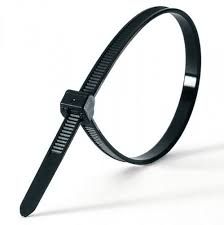Key Performance Factors in Selecting Cable Ties
Selecting the right cable ties goes beyond material choice. Their overall performance depends on several critical factors, including tensile strength, environmental resistance, temperature stability, fire resistance, and flexibility. Ignoring these aspects can lead to premature failure, costly repairs, or safety hazards in demanding applications.
Tensile Strength and Load Capacity
Tensile strength determines how well a cable tie can secure cables under stress. High-tension environments, such as those with constant vibration or movement, require ties that can withstand pulling forces without loosening or snapping. A tie with insufficient load capacity may fail under strain, leading to disorganized or damaged cables.
Resistance to Environmental Factors
Environmental resistance is equally important in ensuring long-term cable tie performance. Moisture and humidity can weaken certain materials, while prolonged UV exposure can cause ties to become brittle and break over time. In chemical-heavy settings, exposure to acids, fuels, solvents, or industrial cleaners can degrade standard ties. Choosing a tie with proper resistance ensures longevity and reduces maintenance needs.
Temperature Stability
Temperature fluctuations can severely impact a cable tie’s durability. Some environments experience extreme conditions, from freezing temperatures to intense heat. A cable tie must retain its strength and flexibility in these conditions without becoming brittle or melting. In industrial and aerospace applications, where equipment must endure both high and low temperatures, temperature resistance is non-negotiable.
Fire and Flame Resistance
Fire resistance is essential in environments where heat exposure is common. Certain cable ties meet fire safety standards to prevent melting, dripping, or igniting when exposed to flames. Electrical systems, aviation, and manufacturing facilities all require ties that comply with strict fire resistance regulations to prevent fire hazards.
Flexibility and Adaptability
Cable ties must be flexible enough to conform to different cable sizes, surfaces, and mounting needs. Some applications require ties that can handle stress, bending, or repetitive movement without weakening. A rigid or poorly designed tie may crack under pressure, while a flexible one can maintain a secure grip for extended periods.
Installation and Maintenance Best Practices for Cable Ties
Proper installation and regular maintenance ensure that cable ties perform optimally throughout their lifespan. Even the highest-quality ties can fail prematurely if they are installed incorrectly or exposed to improper conditions. Understanding how to secure, inspect, and replace cable ties as needed reduces downtime, prevents equipment damage, and enhances workplace safety.
Proper Installation Techniques
Installing cable ties correctly is crucial for long-term durability and effectiveness. Over-tightening can weaken cables and lead to insulation damage, while under-tightening may cause slippage or instability. Using a cable tie tensioning tool helps achieve the right level of tightness without compromising the integrity of the cables. These tools apply consistent pressure and automatically cut excess material, reducing sharp edges that could cause injuries or damage surrounding components.
Placement is another key factor in installation. Cable ties should be positioned in areas with minimal movement or mechanical stress to prevent premature wear. In environments with frequent vibrations, such as manufacturing plants or transportation systems, additional reinforcement—such as multiple ties spaced evenly along the cable—prevents excessive strain on a single point. In high-temperature applications, placing ties away from direct heat sources extends their longevity and prevents thermal degradation.
Regular Inspection and Replacement
Routine inspections ensure that cable ties remain intact and functional. Over time, environmental exposure, mechanical stress, and temperature fluctuations can weaken materials, causing them to crack, loosen, or break. Conducting regular maintenance checks helps identify early signs of wear and allows for timely replacements before failures occur.
Inspection frequency depends on the environment and application. In industrial settings, where chemical exposure or extreme temperatures are common, weekly or monthly checks may be necessary. In less demanding conditions, a quarterly or annual review may be sufficient. When inspecting cable ties, look for signs of brittleness, discoloration, cracks, or fraying edges, all of which indicate material breakdown.
Replacing damaged or worn-out ties is essential to maintaining secure cable management. If a tie shows even minor signs of degradation, it should be replaced immediately to prevent unexpected failures. When replacing ties, ensure that the new ones match the material and performance requirements for the specific application.
Preventing Common Installation Mistakes
Certain installation mistakes can compromise the effectiveness of cable ties. One common issue is overloading bundles, which puts excessive strain on a single tie and increases the likelihood of failure. Distributing the weight across multiple ties ensures even tension and prolongs lifespan. Another frequent mistake is cutting excess tie length incorrectly, which can create sharp edges that may damage nearby insulation or pose safety risks. Using a proper flush-cutting tool eliminates this hazard.
Exposure to incompatible chemicals or extreme environmental conditions can also lead to premature failure. When working in high-moisture, chemical, or high-temperature environments, always verify that the cable ties used are rated for those conditions. Incorrect material selection often leads to weakened performance and reduced durability.



